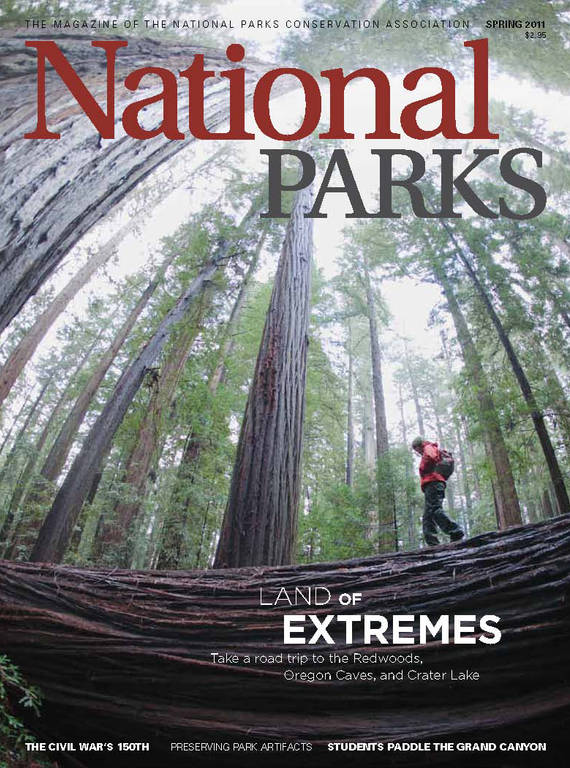Spring 2011
Tree Huggers
Washington D.C.’s tourists were loving its cherry trees to death, until a beaver showed them the way.
On February 14, 1912, more than 3,000 cherry trees left Yokohama, Japan, on board the S.S. Awa Maru, bound for Seattle. Shortly after the floating forest arrived in Washington State, workers carefully transferred the trees to insulated rail cars, which slowly made their way to Washington, D.C. On March 26, this gift from the people of Japan arrived in our nation’s capital. Every year since then, visitors have flocked to the city to see the cherry trees blossom each spring. This year, a million visitors are expected to descend on the Tidal Basin, in the shadow of the Jefferson Memorial, for the two weeks when those clouds of blossoms seem to hover just overhead.
But years ago, park rangers started noticing there weren’t as many blossoms as there used to be. And the thick gnarled trunks of older trees were now outnumbered by fragile trees that never quite reached maturity. The problem? People plucking the flowers, kids climbing the trees and scraping off fragments of bark with every clumsy step, and parents propping their children on low branches for photo-ops—sometimes snapping off limbs in the process.
“The Park Service’s mission is inherently difficult in that we want to preserve forever, but at the same time we want to welcome people to experience our amazing natural and cultural resources—the cherry trees may represent one of the best examples of that challenge,” says John Kirkpatrick, a park ranger with the National Mall and Memorial Parks. “Each year, the Cherry Blossom Festival brings 1 million people to our park in about two weeks. And picking a blossom is the most natural thing in the world. Most people think, ‘Oh, it’s just one flower,’ but if you pick just one flower, you’ve done some damage—you’ve opened a wound, and that lets in viruses and insects. And if you climb a tree, you’re damaging the living part of the tree, which lies just under the bark.”
If it were just one person, the tree would probably do just fine, but add a million other visitors to the equation, and you’ve got a problem. Given the Park Service’s budget woes and the simple arithmetic involved, rangers are wildly outnumbered during the two-week festival, and their duties include far more than policing cherry blossoms. Something had to change.
For years, rangers posted signs urging people not to pick the blossoms or climb on the trees, to little effect. Some rangers suggested more forceful language along with a liberal sprinkling of capital letters and exclamation points. But in the end, the park opted to go the other way. In 2006, Kirkpatrick introduced a friendly cartoon character called Paddles—a beaver armed only with a smile and a stop sign. Paddles made his debut on a trail guide, then progressed to a standing wooden cut-out. Finally, the agency purchased a costume and teamed Paddles with rangers and volunteers to carry his message on foot.
“The response was remarkable,” says Kirkpatrick. “The year before we introduced Paddles, it took me hours to walk from the FDR Memorial to the Washington Monument, because I’d have to stop every time I saw someone with a blossom in their hand. The very next year, all the rangers noticed that people weren’t picking the blossoms nearly as much. Soon, I had to go out of my way to find anyone with a blossom in their hand. It was a dramatic change.”

National Parks
You can read this and other stories about history, nature, culture, art, conservation, travel, science and more in National Parks magazine. Your tax-deductible membership donation of $25 or more entitles…
See more ›Of course, not all the rangers were thrilled with the idea of a character in a costume. Some thought the approach crept dangerously close to Disneyland, and many thought it was inconsistent with the dignity that should be afforded to Jefferson, Lincoln, and Washington. But Kirkpatrick’s colleagues came to recognize that it wasn’t a silly device designed to entertain—it was a tool designed to send an important message regarding the agency’s mission. And it was hard to argue with the results.
Some visitors have brought up more scientific concerns—namely the selection of a beaver as a protector of trees, given their predilection for chopping them down. But Kirkpatrick points out that beavers’ activities generally improve environmental conditions—their dams help form wetlands that support other species. Sure, beavers harvest some trees for specific purposes, just like humans, but even beavers know that there are some trees you don’t touch.
As the cherry blossoms approach their 100th year in the nation’s capital, the message seems to be taking root. This year’s Cherry Blossom Festival begins at the end of March, and the park has already started signing up volunteers to escort Paddles around the Tidal Basin. And that’s good news for the gift that keeps on blossoming.



